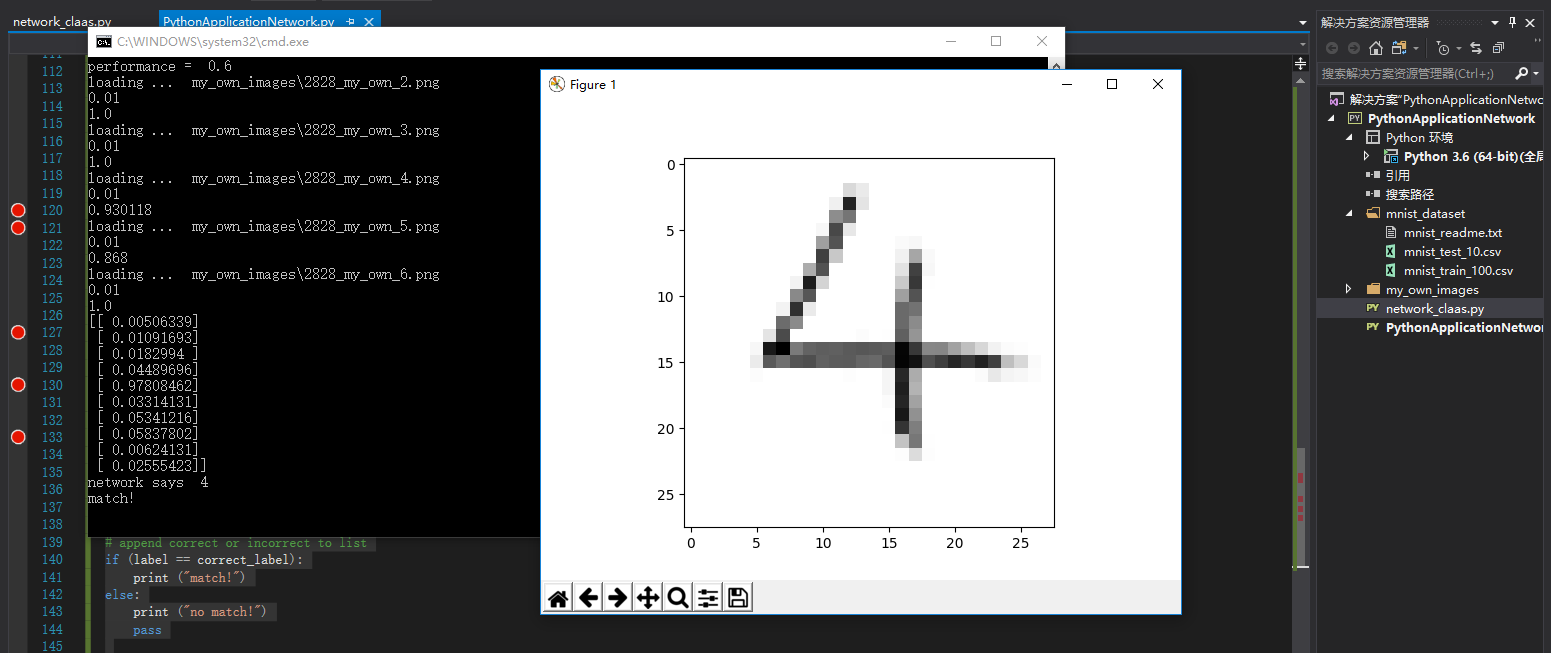深度学习和神经网络对很多初学者来说都是摸不着头脑,今天分享一个完整的手写识别的实例,学习和理解了这个实例代码和过程就基本上掌握了神经网络。
1、构建神经网络类 network_claas.py
#!/usr/bin/env python3 # -*- coding: utf-8 -*- # neural network class definition import scipy.special import numpy # library for plotting arrays import matplotlib.pyplot # helper to load data from PNG image files# helpe import imageio # glob helps select multiple files using patterns import glob class neuralNetwork : # initialise the neural network def __init__(self, inputnodes, hiddennodes, outputnodes, learningrate) : #set number of nodes in each input , hidden , output #初始化网络,设置输入层,中间层,和输出层节点数 self.inodes = inputnodes self.hnodes = hiddennodes self.onodes = outputnodes # link weight matrices, wih and who # weights inside the arrays are w_ i_ j, where link is from node i to node j in the next layer # w11 w21 # w12 w22 etc # 初始化权重矩阵,我们有两个权重矩阵,一个是wih表示输入层和中间层节点间链路权重形成的矩阵一个是who,表示中间层和输出层间链路权重形成的矩阵 self. wih = numpy.random.normal( 0.0, pow( self. hnodes, -0.5), (self. hnodes, self. inodes)) self. who = numpy.random.normal( 0.0, pow( self. onodes, -0.5), (self. onodes, self. hnodes)) # learning rate self.lr = learningrate # activation function is the sigmoid function # 设置激活函数的反函数 self.activation_function = lambda x:scipy.special.expit(x) pass # train the neural network def train(self, inputs_list, targets_list) : # convert inputs list to 2d array #根据输入的训练数据更新节点链路权重 #把inputs_list, targets_list转换成numpy支持的二维矩阵.T表示做矩阵的转置 inputs = numpy.array(inputs_list, ndmin=2).T targets = numpy.array(targets_list, ndmin=2).T # calculate signals into hidden layer #计算信号经过输入层后产生的信号量 hidden_inputs = numpy.dot(self.wih, inputs) # calculate the signals emerging from hidden layer #中间层神经元对输入的信号做激活函数后得到输出信号 hidden_outputs = self.activation_function(hidden_inputs) # calculate signals into final output layer #输出层接收来自中间层的信号量 final_inputs = numpy.dot(self.who, hidden_outputs) # calculate the signals emerging from final output layer #输出层对信号量进行激活函数后得到最终输出信号 final_outputs = self.activation_function(final_inputs) # output layer error is the (target - actual) #计算误差 output_errors = targets - final_outputs # hidden layer error is the output_errors, split by weights, recombined at hidden nodes hidden_errors = numpy.dot(self.who.T, output_errors) #根据误差计算链路权重的更新量,然后把更新加到原来链路权重上 # update the weights for the links between the hidden and output layers self.who += self.lr * numpy.dot((output_errors * final_outputs * (1.0 - final_outputs)), numpy.transpose(hidden_outputs)) # update the weights for the links between the input and hidden layers self.wih += self.lr * numpy.dot((hidden_errors * hidden_outputs * (1.0 - hidden_outputs)), numpy.transpose(inputs)) pass # query the neural network def query(self, inputs_list) : #根据输入数据计算并输出答案 # convert inputs list to 2d array inputs = numpy.array(inputs_list, ndmin=2).T #计算中间层从输入层接收到的信号量 # calculate signals into hidden layer hidden_inputs = numpy.dot(self.wih, inputs) #计算中间层经过激活函数后形成的输出信号量 # calculate the signals emerging from hidden layer hidden_outputs = self.activation_function(hidden_inputs) #计算最外层接收到的信号量 # calculate signals into final output layer final_inputs = numpy.dot(self.who, hidden_outputs) # calculate the signals emerging from final output layer final_outputs = self.activation_function(final_inputs) return final_outputs
2、初始化及训练测试该网络
#!/usr/bin/env python3
# -*- coding: utf-8 -*-
from network_claas import neuralNetwork
import numpy
import matplotlib
import glob
import imageio
# library for plotting arrays
import matplotlib.pyplot as plt
import pylab
# ensure the plots are inside this notebook, not an external window
#初始化网络
# number of input, hidden and output nodes
input_nodes = 784
hidden_nodes = 100
output_nodes = 10
#初始化学习率
# learning rate is 0.3
learning_rate = 0.3
# create instance of neural network
# 初始化神经网络
n = neuralNetwork(input_nodes,hidden_nodes,output_nodes, learning_rate)
# load the mnist training data CSV file into a list
training_data_file = open("mnist_dataset/mnist_train_100.csv", 'r')
training_data_list = training_data_file.readlines()
training_data_file.close()
# train the neural network
# epochs is the number of times the training data set is used for training
epochs = 5
for e in range( epochs):
# go through all records in the training data set
for record in training_data_list:
# split the record by the ',' commas
all_values = record.split(',')
# scale and shift the inputs
inputs = (numpy.asfarray( all_values[1:]) / 255.0 * 0.99) + 0.01
# create the target output values (all 0.01, except the desired label which is 0.99)
targets = numpy.zeros(output_nodes) + 0.01
# all_values[0] is the target label for this record
targets[int(all_values[0])] = 0.99
n.train(inputs, targets)
pass
# load the mnist test data CSV file into a list
test_data_file = open("mnist_dataset/mnist_test_10.csv", 'r')
test_data_list = test_data_file.readlines()
test_data_file.close()
# test the neural network
# scorecard for how well the network performs, initially empty
scorecard = []
# go through all the records in the test data set
for record in test_data_list:
# split the record by the ',' commas
all_values = record.split(',')
# correct answer is first value
correct_label = int( all_values[ 0])
# scale and shift the inputs
inputs = (numpy.asfarray( all_values[ 1:]) / 255.0 * 0.99) + 0.01
# query the network
outputs = n.query( inputs)
# the index of the highest value corresponds to the label
label = numpy.argmax( outputs)
# append correct or incorrect to list
if (label == correct_label):
# network' s answer matches correct answer, add 1 to scorecard
scorecard.append( 1)
else:
# network' s answer doesn' t match correct answer, add 0 to scorecard
scorecard.append( 0)
pass
pass
# calculate the performance score, the fraction of correct answers
scorecard_array = numpy.asarray( scorecard)
print ("performance = ", scorecard_array.sum() / scorecard_array.size)
# our own image test data set# our o
our_own_dataset = []
# load the png image data as test data set
for image_file_name in glob.glob('my_own_images/2828_my_own_?.png'):
# use the filename to set the correct label
label = int(image_file_name[-5:-4])
# load image data from png files into an array
print ("loading ... ", image_file_name)
img_array = imageio.imread(image_file_name, as_gray=True)
# reshape from 28x28 to list of 784 values, invert values
img_data = 255.0 - img_array.reshape(784)
# then scale data to range from 0.01 to 1.0
img_data = (img_data / 255.0 * 0.99) + 0.01
print(numpy.min(img_data))
print(numpy.max(img_data))
# append label and image data to test data set
record = numpy.append(label,img_data)
our_own_dataset.append(record)
pass
# record to test
item = 2
# plot image
plt.imshow(our_own_dataset[item][1:].reshape(28,28), cmap='Greys', interpolation='None')
# correct answer is first value
correct_label = our_own_dataset[item][0]
# data is remaining values
inputs = our_own_dataset[item][1:]
# query the network
outputs = n.query(inputs)
print (outputs)
# the index of the highest value corresponds to the label
label = numpy.argmax(outputs)
print("network says ", label)
# append correct or incorrect to list
if (label == correct_label):
print ("match!")
else:
print ("no match!")
pass
pylab.show()3,输出如下:

4,完整代码如下:

发表评论